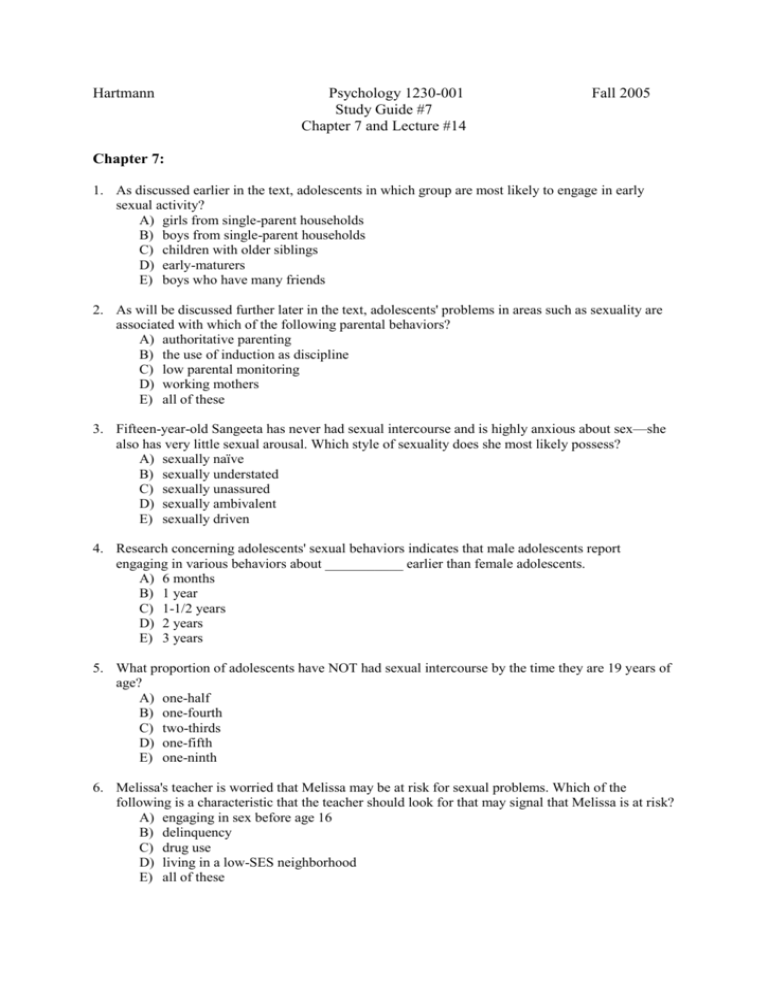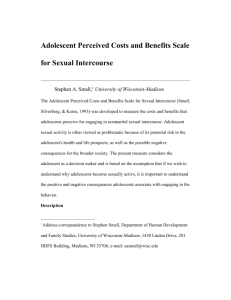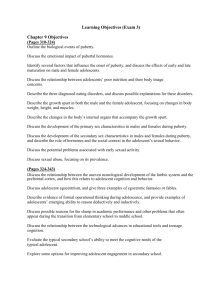
Hartmann
Psychology 1230-001
Study Guide #7
Chapter 7 and Lecture #14
Fall 2005
Chapter 7:
1. As discussed earlier in the text, adolescents in which group are most likely to engage in early
sexual activity?
A) girls from single-parent households
B) boys from single-parent households
C) children with older siblings
D) early-maturers
E) boys who have many friends
2. As will be discussed further later in the text, adolescents' problems in areas such as sexuality are
associated with which of the following parental behaviors?
A) authoritative parenting
B) the use of induction as discipline
C) low parental monitoring
D) working mothers
E) all of these
3. Fifteen-year-old Sangeeta has never had sexual intercourse and is highly anxious about sex—she
also has very little sexual arousal. Which style of sexuality does she most likely possess?
A) sexually naïve
B) sexually understated
C) sexually unassured
D) sexually ambivalent
E) sexually driven
4. Research concerning adolescents' sexual behaviors indicates that male adolescents report
engaging in various behaviors about ___________ earlier than female adolescents.
A) 6 months
B) 1 year
C) 1-1/2 years
D) 2 years
E) 3 years
5. What proportion of adolescents have NOT had sexual intercourse by the time they are 19 years of
age?
A) one-half
B) one-fourth
C) two-thirds
D) one-fifth
E) one-ninth
6. Melissa's teacher is worried that Melissa may be at risk for sexual problems. Which of the
following is a characteristic that the teacher should look for that may signal that Melissa is at risk?
A) engaging in sex before age 16
B) delinquency
C) drug use
D) living in a low-SES neighborhood
E) all of these
Psychology 1230-001 (Hartmann)
Fall’05, Study Guide #7, p. 2 of 4
7. In a study of gay adolescent males, three stages of coming out were conceptualized. What is the
first stage?
A) awareness
B) sensitization
C) acceptance
D) denial
E) confusion
8. By 1995, the percentage of adolescent girls who used contraceptives at first intercourse reached
A) 26 percent.
B) 44 percent.
C) 57 percent.
D) 78 percent.
E) 92 percent.
9. What percentage of U.S. school districts in the South (where the teenage pregnancy rate is above
the norm) teach abstinence-only sex education and either do not discuss contraception or say that
it is ineffective?
A) 5%
B) 10%
C) 25%
D) 40%
E) 55%
10. Larry, age 16, is a typical adolescent father. That likely means that he
A) is still in school, but leaves early each day.
B) has a low-paying job.
C) abuses his child.
D) tries to be involved in the life of his child.
E) has a below-average IQ.
11. Approximately what percent of sexually active adolescents is estimated to become infected with
an STI each year?
A) 5 percent
B) 15 percent
C) 25 percent
D) 50 percent
E) 65 percent
12. Five days after sexual contact Angeline develops itching and tingling, followed by eruptions of
painful sores and blisters on her genitals and inner thighs. What STI does she most likely have?
A) herpes
B) gonorrhea
C) syphilis
D) chlamydia
E) AIDS
13. In a recent study, what percentage of 14- to 26-year-old females believed that they never have the
right to a) tell their male partner he's being too rough, b) decide on what birth control to use, and
c) stop foreplay at any time?
A) 1%
B) 5%.
C) 10%
D) 20%
E) 50%
Psychology 1230-001 (Hartmann)
Fall’05, Study Guide #7, p. 3 of 4
14. Approximately what proportion of sexual victimization incidents are committed by romantic
acquaintances?
A) one fifth
B) one fourth
C) one half
D) three fourths
E) two thirds
15. Tony is an adolescent with some inaccurate information about sex. According to some
researchers, the important missing ingredient in adolescent sex education for people like Tony is
A) peers.
B) parents.
C) literature.
D) schools.
E) physicians.
16. Which of the following statements about adolescents' sexual knowledge is TRUE?
A) Boys obtain information from their fathers, whereas girls obtain information from their
mothers.
B) A majority of adolescents say that they talk to their parents about sexual matters.
C) Reading about sex is one of the most common ways adolescents get information.
D) Adolescents' initial information about masturbation is more likely to be obtained from
their fathers than their mothers.
E) Girls and boys do not differ in their frequency of conversations with their mothers about
sex.
17. In recent years Americans have increasingly supported sex education in the schools. What is the
main reason for this increase in support?
A) the rapidly increasing teenage pregnancy rate
B) increasing acceptance of explicit sexual material in the media
C) the huge increase in HIV/AIDS and other STIs
D) the large increase in date rape
E) sexual harassment occurring in schools
18. The adolescent pregnancy rate in Sweden is among the lowest in the world. Swedish adolescents
A) become sexually active at an older age than American adolescents.
B) see less explicit sex on television than American adolescents.
C) do not learn about contraception in school; thus, they are given the message that sex is not
condoned.
D) receive a thorough grounding in reproductive biology and contraception.
E) receive a clear message from teachers and parents that sex is for married adults.
19. Fifteen-year-olds Antoine and Carrie are engaging in sexual exploration, but not sexual
intercourse. Brooks-Gunn and Paikoff believe that
A) the exploration will inevitably lead to intercourse.
B) exploration is even more unhealthy than intercourse for adolescents.
C) this is healthy sexual behavior for adolescents.
D) both will develop sexual behavior problems as adults.
E) both sexual exploration and intercourse are unhealthy behaviors for young adolescents.
Psychology 1230-001 (Hartmann)
Fall’05, Study Guide #7, p. 4 of 4
20. One suggestion for educating adolescents about parenthood is to have them do community service
at
A) a family planning center.
B) a child-care center.
C) an adoption agency.
D) a neonatal intensive care unit.
E) a maternity ward.
Essay Questions:
1. Describe the variables related to the failure of sexually active adolescents to use
contraceptives. How can we counteract this failure?
2. 2. Characterize the source and content of adolescent sexual knowledge. How might
information be disseminated to more adequately inform adolescents and their other sources of
information?
Lecture #14:
1.
The standard which states that sexual intercourse before marriage is permissible for males but
not for females is sometimes referred to as the
a.
traditional standard
b.
double standard
c.
permissiveness with affection standard
d.
male-dominance standard
e.
Virgin-Mary standard
2.
According to the lecture it has been reported that _____________ proportion of children
engage in some sex play with a member of the same sex before puberty?
a.
practically none
b.
a small minority (e.g., <25%)
c.
almost 50%
d.
a sizable majority (e.g., 75%)
e.
almost everyone; haven't you heard of doctor-nurse games?
3.
The bulk of evidence suggests that the primary effect of not providing birth control information
to teens is that they
a.
may use intrauterine devices, which may prove injurious.
b.
are less likely to engage in sexual intercourse.
c.
are more likely to use retreaded condoms.
d.
are more likely to become pregnant.
e.
likely will have higher GPAs.
4.
A correlation of .8 between the level of romanticism of teenage girls and their boyfriends is
best interpreted in the following manner:
a.
the correlation is better than a correlation of -.8.
b.
members of a partnership have reciprocal affects on one another's romanticism.
c.
the correlation is almost twice as good as a correlation of .4.
d.
unromantic girls tend to have unromantic boyfriends.
e.
All of the above.
5.
If you plan on using Coca Cola as a birth control device you should
a.
drink it at least 15 minutes before engaging in sex.
b.
be certain that both participants drink a minimum of 8 ounces.
c.
choose Diet Coke.
d.
avoid the missionary position unless you use caffine-free Coke.
e.
all of the above.







